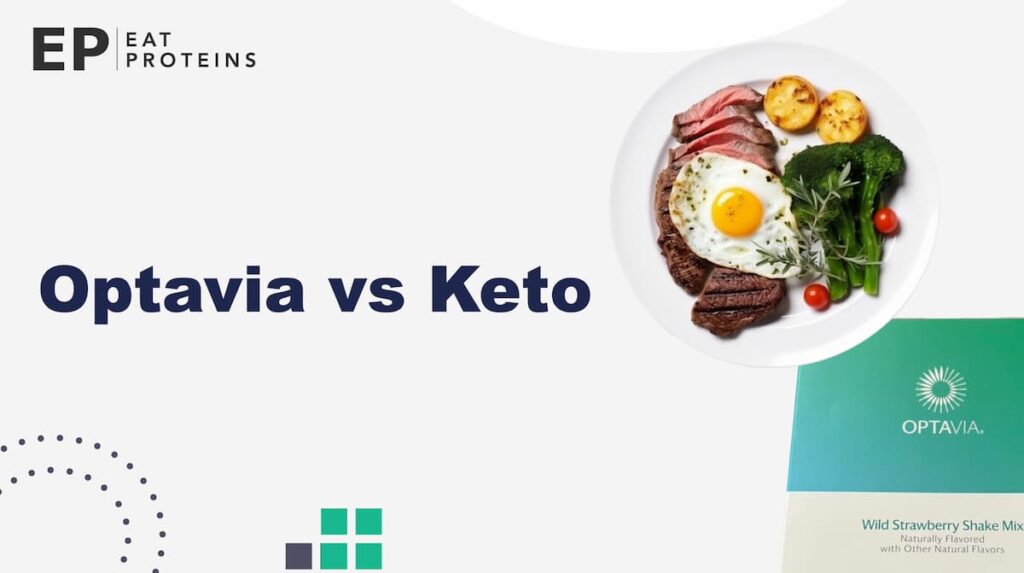
The Optavia and Keto diets are both popular low-carb options, each with its unique features and differences. It’s essential to understand these distinctions to choose the diet that aligns best with your personal health goals and lifestyle.
First things first, is Optavia keto? No, Optavia is not a ketogenic diet, but a low-calorie weight loss program that combines prepared and packaged meals, as well as coaching and community support. The most popular 5 and 1 plan involves eating five Optavia Fuelings and one Lean and Green meal.
On the other hand, the Ketogenic diet refers to a low-carbohydrate, high-fat diet that aims to induce a metabolic state called ketosis. In the Keto Diet, the macronutrient distribution typically consists of approximately 55-60% fat, 30-35% protein, and 5-10% carbohydrates. Picking between the two isn’t as simple as you’d think. In this comparison review, I’m explaining the differences between Optavia and Keto, helping you decide which diet is better, and how they stand out from other diet options out there. I’ll also provide tips on transitioning from Optavia to Keto.
What is the Optavia Diet?
The Optavia Diet is a weight loss program that is a subsidiary of Medifast Inc. It is best known for its Optimal Weight 5 & 1 Plan, which involves consuming meal replacements called “Fuelings” that contain 100-110 calories each. In addition to these Fuelings, the program includes one “lean and green” meal per day, which consists of lean protein and low-carb vegetables. The goal is to lose 1-2 pounds weekly, and they offer personal coaching and an online group for extra help and motivation.
The main benefit of the Optavia diet is fat loss, as demonstrated by a 2019 study conducted by Linda M. Arterburn from Medifast. They did a 16-week study where participants on the Optavia 5&1 Plan with phone coaching lost about 5.7% of their body weight, which was way more than those who just tried to eat less on their own. However, most of Optavia’s studies are funded by Medifast, Inc., so just something to keep in mind.
What is a Ketogenic Diet?
The ketogenic diet is a popular high-fat, low-carbohydrate diet that has been effective in the treatment of epilepsy. The ketogenic diet has gained popularity in recent years as a short-term weight loss intervention.
Similarly to the Optavia diet, the main benefit of the Keto diet is fat loss. The 2022 study by Chong Zhou from Wuhan Sports University shows that the ketogenic diet is highly effective for weight loss, particularly for patients with Type 2 Diabetes Mellitus (T2DM). Notably, the ketogenic diet was found to be more effective in reducing body weight in overweight T2DM patients compared to other diets.
However, the main drawback of the ketogenic diet is the potential for short-term adverse effects, commonly referred to as “keto flu.” These symptoms may include nausea, vomiting, headache, fatigue, dizziness, insomnia, reduced exercise tolerance, and constipation. Additionally, long-term adherence to the strict macronutrient distribution of the ketogenic diet can be difficult, leading to potential nutrient deficiencies.
Optavia vs Keto: What’s the difference?
I’ve found that the main differences between Optavia and Keto really boil down to their cost, products, meal plans, availability, results, and what people are saying about them.
Price
I’ve noticed a significant cost difference between Optavia and Keto. Optavia can be expensive due to the cost of their meal replacements and coaching. For example, the Optavia 5 and 1 plan costs around $511.50 per month for 154 servings. If you opt for the Optavia 5 and 1 ACTIVE plan, it’s even more expensive at $571.45 per month becasue it includes 184 servings and additional amino acids. Additionally, you’ll need to budget for Lean and Green meals, which can range from $10 to $20 per day, depending on your menu choices. In total, the monthly expenses for Optavia can easily exceed $1,000 to $1,200 per person.
In contrast, the Keto diet is much kinder to my wallet, although the actual cost varies based on what I choose to buy and how I shop. In my experience, I can spend anywhere from $400 to $800 each month, which breaks down to about $15 to $30 daily. This feels more manageable for my budget, but I’ve noticed the expenses can climb if I opt for fancier food items like high-quality meats and seafood. Here’s a photo of how much meat per day I and my wife used to cook on the Ketogenic Diet.

That doesn’t mean the Keto diet is cheap. According to the United States Department of Agriculture (USDA), the average woman in the United States spends around $243 per month on groceries. However, those on the Keto diet could find themselves spending close to $800 per month just on meat, making it potentially less affordable in the long run.
The average price for ground beef right now is sky-high ($5.35 per pound), which is 26.26% more than it was in 2020 according to the Federal Reserve Bank of St. Louis. But even with meat and dairy prices going higher each year, the Keto diet is still more budget-friendly than Optavia. This table shows price differences between Keto and Optavia.
| Diet Plan | Monthly Cost ($) |
|---|---|
| Optavia 5 and 1 Plan | 511.50 |
| Optavia 5 and 1 ACTIVE Plan | 571.45 |
| Keto (Low Budget) | 400.00 |
| Keto (High Budget) | 800.00 |
Where to buy
I’ve noticed that the availability of the Keto diet and Optavia is quite different, each offering varying levels of convenience and accessibility. From my experience, the Keto diet is extremely accessible. I can easily find Keto-friendly foods in most grocery stores and online, and there’s no need to enroll in a specific program. Additionally, I’ve found a ton of information, recipes, and cookbooks dedicated to the Keto lifestyle, which makes it easy to follow.
In contrast, the Optavia products are mainly sold through their official website, which kind of limits where I can buy them. However, I’ve seen some unopened Optavia Fuelings being sold on platforms like eBay, Facebook Marketplace, and Craigslist at a discounted price, but be careful as some of them have already expired.
Grocery shopping
The grocery shopping experiences for Optavia and Keto are notably different, offering varied approaches to diet and lifestyle. The most obvious difference for me was the types of foods I could purchase. With Optavia, I was able to include a wider range of foods, and carbs, which are typically off-limits in the Keto diet. This shift meant I didn’t have to obsess over calorie or carb counting as much; I could simply eat until satisfied. Here’s a photo of what I like to eat on Optavia 5 and 1 meals.

Convenience plays a big role in my diet choices. With Optavia, I find myself shopping less often, sometimes just once a week, because many of my meals are pre-packaged or come as meal replacements. On the other hand, when I followed the Keto diet, I had to do regular grocery shopping to make sure I always had fresh, high-fat, low-carb foods available.
Meal Plan
I’ve tried both the Optavia and Keto meal plans, and they really are different in how they approach weight loss and meal prep. With Optavia, it’s pretty straightforward for most of the day; I only have to cook one “Lean and Green” meal daily made from lean proteins and low-carb veggies. The rest of my meals are Optavia’s “Fuelings” – they’re ready-to-eat, perfectly portioned, and each is about 100-110 calories. Here’s the photo of my Optavia meal (loaded with meat, as usual).

Switching to Keto, I found I had to prepare all my meals, focusing on high-fat, low-carb foods. Thankfully, there are keto-friendly meal delivery services, restaurants, and takeouts that made my life easier. From my experience, Optavia offers more convenience with its structured plan, while Keto gives more flexibility but requires more effort in meal preparation.
Taste
In my experience, Keto meals have a richer, more satisfying flavor due to the abundance of meats and cheeses. I’ve found that they’re heavier and more indulgent compared to Optavia Fuelings. However, managing portion sizes on a Keto diet is challenging; it often requires diligent calorie counting and food measuring. On the other hand, Optavia Fuelings, while convenient, can start to feel a bit monotonous and less flavorful over time.
Customer reviews
I’ve read through a lot of customer reviews on Optavia and Keto diets, and the differences in experiences stand out. When it comes to Keto, a lot of people, including myself, have noticed some serious weight loss, a boost in energy, and clearer thinking. We think it’s because of ketosis and cutting down on carbs. But I won’t lie, the first few weeks were tough with cravings, and finding Keto-friendly meals when eating out can be a real challenge.
In contrast, Optavia’s customer reviews are more critical, with a TrustScore of just 2.5 out of 5. Many customers express disappointment with the lack of variety in Optavia’s products, mentioning that the food needs improvement. The coaching aspect receives mixed reviews, too, but the low overall rating indicates general dissatisfaction with the program. Notably, 67% of the reviews are just 1-star, indicating strong dissatisfaction among a significant portion of Optavia diet users. Overall, Keto seems to enjoy more positive customer experiences, and Optavia struggles with lower customer satisfaction.
Optavia vs Keto: Pros and Cons
I’ve tried both the Keto and Optavia diets, and I’ve noticed they each have their ups and downs. With Keto, I really liked the quick weight loss and got to enjoy lots of high-fat foods, which was great. However, I found it pretty restrictive and sometimes had side effects that weren’t so pleasant. As for Optavia, it was super convenient and made weight loss simpler, but it was a bit pricey and I felt like I had less control over what I ate (which is why I started doing Optavia on my own).
Both diets helped boost my energy levels and I lost weight on them, but they work in totally different ways. When it comes down to it, choosing between Optavia and Keto depends on what you’re looking for in a diet, your lifestyle, and how much freedom you want in planning your meals.
Which is better Keto versus Optavia?
Based on my experience, I find the keto diet better for individuals seeking a high-fat, low-carb lifestyle that potentially enhances fat-burning and weight loss. Ketogenic diets show short-term weight loss benefits, as per a 2022 study by Erin McGaugh, MD, from the University of Missouri–Kansas City School of Medicine, but their long-term effectiveness is similar to that of calorie-restricted diets. However, the Optavia diet may be a better choice if you prefer a structured plan with pre-packaged meals and coaching support, especially if you’re new to dieting or need guidance.
What are the alternative diets to Optavia and Keto?
Alternative diets to Optavia and Keto include the Weight Watchers, GOLO, Atkins, NOOM, Nutrisystem, and Jenny Craig diets, providing a variety of options for individuals seeking different approaches to weight management and nutrition. However, if you’re looking for almost identical Optavia diet alternatives, I suggest looking up the Skinny Box diet, WonderSlim, and Profile by Sanford.
Can you do Keto and Optavia together?
Yes, you can combine Keto and Optavia by modifying your lean and green meals to be keto-friendly and limiting your Fuelings to 1-2 per day. This approach can help you maintain a ketogenic state while benefiting from the structure of the Optavia program.
Is it possible to achieve ketosis while on the Optavia diet?
Yes, it is possible to achieve ketosis on the Optavia diet, especially if you choose their lower-carb meal options and manage your overall carbohydrate intake.
How to transition from Optavia to keto?
To transition from Optavia to keto, gradually increase your intake of healthy fats and reduce carbs to meet keto’s macronutrient ratios. Also, focus on including more whole, keto-friendly foods while phasing out Optavia-specific meals and snacks.
Is Optavia keto?
No. Optavia is not a Ketogenic diet because it is not considered a highly restrictive low-carbohydrate diet and does not put you in ketosis. Unlike the keto diet where you consume high amounts of fat, moderate protein, and minimal carbs, Optavia does not follow this pattern.
Does Optavia use keto recipes?
Yes, Optavia incorporates some keto-friendly recipes in its diet plans.

